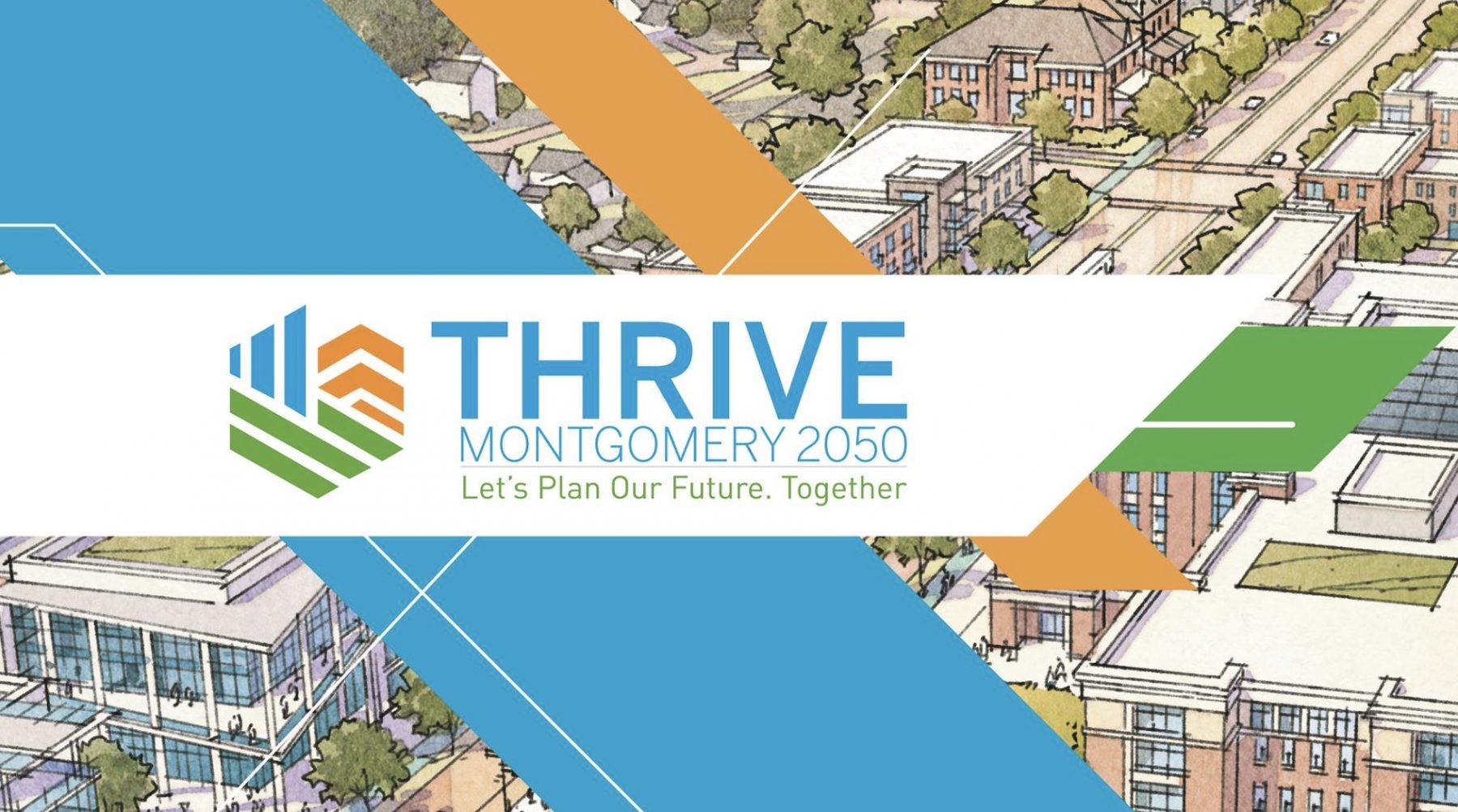A vibrant economy, equity for all residents, and a healthy environment through 2050 and beyond
Thrive Montgomery 2050 guides the future of Montgomery County as we come together to realize an equitable vision that works for all of us. As the long-awaited first comprehensive update to the county’s General Plan in nearly 60 years, Thrive builds on what works in Montgomery County—and reimagines what doesn’t.
This data-driven and community-informed plan emphasizes critical issues, including racial equity and social justice, diverse pedestrian needs, and climate concerns that weren’t the main considerations of land use planning when the General Plan was adopted in 1964 but are now integral to our community and our priorities.
Today, this updated plan will help realize lasting positive change for the Montgomery County of today and tomorrow by envisioning a clear path forward to increase accessible housing, improve transit, and strengthen the economy in equitable, sustainable ways. With this framework, we can realize a Montgomery County centered on accessible, mixed-use corridors connecting residents, employees, and visitors to each other and to the region.
አማርኛ | 汉语 | Español | فارسی |Français | 한국어 | Tiếng Việt
- Thrive Montgomery 2050 Outreach and Engagement Appendix
- Thrive Montgomery 2050 Actions and List of Resources
- View the Thrive Montgomery 2050 two-page explainer: English | አማርኛ | 汉语 | Español | فارسی | Français | 한국어 | Tiếng Việt
Key Recommendations
- Focus on growth in downtowns, activity centers, and along major corridors—with amenities serving existing and new residents while preserving our open spaces.
- Prioritize racial equity and social justice– throughout the county and make all areas of the county equally diverse with equal access to affordable housing, economic opportunities, better education, transit, and other public and private amenities.
- Increase the County’s economic competitiveness— by providing the kind of infrastructure, services, and amenities that can strengthen our ability to compete effectively in the future.
- Emphasize walking, biking, and transit—to reduce car traffic, minimize emissions, and keep everyone safer in their travels.
- Embed social connections and public health into our land use planning— to create places that encourage and make it easier for people to meet others and engage in activities.
- Enhance public and private spaces alike with arts and culture—because quality of place is integral to quality of life, as well as shared economic health.
- Target place-based environmental sustainability and resilience—so growth happens in already-developed areas and the Agricultural Reserve and parkland remain protected for future generations.
- Build more housing to better match housing supply with demand— to ensure our residents can be housed in appropriate-for-them homes at reasonable price points.
Thrive Montgomery 2050 Outcomes
Racial equity and social justice
A place where all residents have equal access to affordable housing, healthy foods, employment, education, and more.
Environmental resilience
An environment that preserves both natural and built resources and uses the best strategies available to fight climate change and mitigate the impacts of development.
Economic competitiveness
A vibrant, strong, and competitive economy that supports large and small businesses and business innovation and that attracts and retains a high-quality, diverse workforce.
Growth Corridors
Thrive Montgomery 2050 proposes to concentrate development along major corridors to maximize the efficiency of infrastructure, preserve land, and focus investment. These corridors connect residents to existing and future centers of activity. These corridors also either have transit service in place or planned or are located close to existing concentrations of jobs, services, and infrastructure, which allows them to support more intensive development to produce complete communities, and preserve habitat in stream valley parks, regional parks, and outlying areas of the county. The intensity of development along these corridors should be aligned with the urban, suburban, and rural context of the surrounding area and calibrated to account for existing or planned transit and other transportation infrastructure. Detailed analysis, and exact boundaries of each corridor growth area, will come through future planning efforts that includes extensive public engagement.
The corridors are:
- Rockville Pike (MD 355) between Washington, DC and Clarksburg;
- Georgia Avenue (MD 97) between Washington, DC and Olney Town Center;
- Colesville Road/Columbia Pike (Rt 29) between Washington, DC and Burtonsville;
- New Hampshire Avenue (MD 650) between Washington, DC and Randolph Road;
- Connecticut Avenue (MD 185) between Washington DC and Georgia Avenue;
- University Boulevard between Prince George’s County boundary and Connecticut Avenue;
- Veirs Mill Road (MD 586) between Georgia Avenue in Wheaton and Rockville Pike in Rockville;
- Randolph Road/Old Georgetown Road/Rock Spring Drive between Rock Spring and Columbia Pike (Route 29); and
- River Road between Washington, DC and the Capital Beltway (I-495).
Frequently Asked Questions
Montgomery County is a great place to live, work, and play. But it didn’t happen by accident. The great communities, places, and spaces that keep us calling Montgomery County home — like vibrant parks; quality schools; desirable urban, suburban and rural communities; and the Agricultural Reserve — have all been shaped by visionary land use plans.
The original general plan, On Wedges and Corridors, set out a long-term land use vision for the county based on the challenges of the era, including housing the post World War II population and economic boom, guiding the orderly development of the suburbs, and preserving natural resources.
The kind of forward thinking, imagination and dedication demonstrated in previous decades has allowed our community to thrive today. At the same time, our challenges have changed. The population is still growing, but not as quickly as 50 years ago. Housing prices are getting out of reach for many residents because supply has not kept up with demand. We are out of land for new development, so must change our planning approach to shift from greenfield development to infill and redevelopment.
For Montgomery County to continue to thrive — and become an even better home for all — we must make those big decisions again and take bold steps for our future and that of generations to come. Thrive Montgomery 2050 reorients our land use planning framework to reflect today’s realities of land and resource constraints. The plan will help us work more effectively to increase our economic competitiveness, address the challenges of climate change, and promote racial equity and social justice.
Equity is at the core of what we do, and we take its role in planning very seriously. The Planning Department’s Equity Agenda informed Thrive at every step, from conception to drafting to refining, as we aim to break down barriers and empower every person to live well and thrive in Montgomery County now and in the future.
From the beginning, our goal with this plan outreach was to meet community members where they are, so we kicked off the plan update with an extensive series of events throughout the county and in partnership with other community groups, such as the Regional Services Centers, the Parks Department, and local farmers markets. Through in-person and online outreach activities, we created opportunities for residents to provide feedback on Thrive in ways that were easy, comfortable, accessible, and convenient for them. We spoke with any and every community group that requested our presence, and attendance at online meetings was roughly double what we had seen at in-person-only events before the COVID-19 pandemic. More participation in the planning process is always a good thing, and we plan to continue these practices in the future. Detailed information about our outreach is included in the Thrive Montgomery 2050 Outreach and Engagement Appendix.
A General Plan like Thrive does not change zoning or other regulations, nor does it provide specific land use guidance to address short-term issues in targeted geographic areas. It instead addresses multiple topic areas at a high-level policy range, and it clearly identifies potential areas of zoning changes to explore in the future. But these are ideas and possible recommendations only.
Though Thrive Montgomery 2050 will be implemented through zoning changes (like zoning text amendments) identified by future master plans and studies and other changes to county regulations and ordinances, any zoning changes would take place either through local master plan efforts or through amendments to the county’s Zoning Ordinance. Both of those methods require multiple opportunities for public input before the County Council makes any changes to zoning.
Thrive Montgomery 2050 does not directly change single-family zoning anywhere in the county. It focuses on expanding housing choices so that residents have more options that they can afford and that meet their varied needs.
Montgomery County has well-documented shortages of affordable and attainable housing, and neighborhoods dedicated exclusively to single-family houses often leave residents detached from retail and other services, encourage the construction of stand-alone public facilities, and perpetuate the inefficient use of land.
Thrive Montgomery 2050 aims to ensure that exclusively single-family zoning is not a barrier to development in many Montgomery County neighborhoods. This is an important step in how the county begins to address past inequities in housing choice, while also creating more options for housing that is affordable and attainable to current and future residents of all income levels.
Montgomery County’s diverse communities have a wide variety of needs in terms of housing— including affordability, the size and type of housing and proximity to transit, and the types of housing residents need or can afford also can change throughout their lives. The county also has a housing supply gap that will continue into the future. Montgomery County’s residents are already seeing housing prices increasing, making parts of the county unaffordable for too many of our residents. We need more options.
Plus, we know that a range of housing types priced for a range of incomes is essential to integration and equity. That’s why Thrive encourages the enabling and development of more housing of all kinds that are available at all price points. This includes single-family housing, “missing middle housing” (such as duplexes, cottages, and quadplexes), and low, mid-rise, and high-rise apartment buildings.
Thrive Montgomery 2050 envisions a safe, comfortable, and appealing transportation system accessible for all residents, whether they drive, take transit, walk, roll, or bike. It proposes focusing future growth on corridors, through infill and redevelopment, and retrofit existing roads to be safer—a necessity after decades of streets and communities oriented mainly to driving that have created unsafe walking or biking routes countywide. Ideally, while people will still drive, it will also be easier to exercise alternatives, which will also help reduce both traffic congestion and greenhouse gas emissions. Additionally, Montgomery County can accommodate more residents and workers more sustainably.
Thrive Montgomery 2050 explicitly supports protecting the Agricultural Reserve for future agricultural use and its myriad environmental benefits, noting how it should remain relevant and accessible so that all residents can value the “green lungs” and jewel of the county. Importantly, the plan also directs future growth away from the Reserve, so it can maintain its rural character, and strengthens the need for the rural pattern of development.
The goal of Thrive Montgomery 2050 is to change how we plan for more compact—and thus, more efficient, cost effective, and sustainable—development. That said, the plan itself will be implemented through other scopes of work over several decades, so a single-number estimate is impossible to generate.
Regardless, growth is coming and must be accommodated and paid for under any scenario. According to the Cooperative Forecast produced by the Metropolitan Washington Council of Governments (MWCOG) in 2021 estimates that Montgomery County will grow by nearly 200,000 people by 2050. The plan’s focus on infill development along corridors that have or are planned to have infrastructure means that there will be less need to build new roads and extend infrastructure—leading to cost savings.
In addition, if the recommendations in Thrive Montgomery 2050 are implemented, the county will be more attractive to businesses, employers, and future residents, growing its tax base and bringing in new employers with better job opportunities.
The General Plan and Process
Thrive Montgomery 2050 is the long-awaited update to our county’s General Plan—the policy document that envisions what the future of Montgomery County could look like when we come together to realize an equitable vision that works for all of us. This planning process began formally in June 2019. Despite the COVID-19 pandemic, Montgomery Planning staff persisted in our community engagement, moving presentations, work sessions, and public hearings online and ensuring that the full breadth of Montgomery County’s diverse populations were meaningfully represented in outreach and feedback efforts.
The resulting plan is a long-range guide for the development of our county. In Maryland, every jurisdiction must legally adopt some form of comprehensive, 30-year plan of this nature to provide broad guidance for land use decisions as we face multiple, unpredictable future opportunities and challenges that influence growth and development, from disruptions like pandemics to innovations such as autonomous vehicles. Going forward, Thrive will be the defining framework through which other plans and development in Montgomery County will arise, and it provides consistent directions for decisions about land use, transportation, and related issues under local government influence.
Ultimately, Thrive Montgomery 2050 offers a blueprint for new approaches that are needed immediately and will extend over a period of decades. These strategies aim to accommodate growth in ways that make room for new residents and improve the quality of life for the people who already live here. The plan anticipates a county that will become more urban, more diverse, and more interconnected. It guides us to leverage growth and redevelopment to create places that are more economically competitive, foster a stronger sense of trust and inclusiveness among people from different backgrounds, and improve environmental quality and public health in the process.




